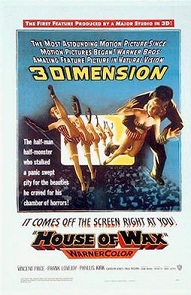
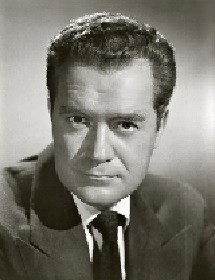 Night Beat (1950-52) aired “Pay up or Die” on May1, 1952 as its 92nd episode out of approximately 118 (depending on how one counts). Some 80 episodes are estimated to remain in circulation. This radio noir “detective” show featured film–-and later TV–-star Frank Lovejoy (1912-1962) as Randy Stone, the night beat reporter for the fictional Chicago Star newspaper.
Night Beat (1950-52) aired “Pay up or Die” on May1, 1952 as its 92nd episode out of approximately 118 (depending on how one counts). Some 80 episodes are estimated to remain in circulation. This radio noir “detective” show featured film–-and later TV–-star Frank Lovejoy (1912-1962) as Randy Stone, the night beat reporter for the fictional Chicago Star newspaper.
This is the 9th episode of Night Beat we have showcased, the first being “The Devil’s Bible” from July of 2013. This is but the 2nd since August of 2022, so a bit of background is in order for newcomers. While well received, Night Beat ran for a modest two years before being cancelled, but not from any fault of its own. It had two factors going against it, both with origins at NBC. The time for a new radio show, and for a network to pour money into it, wasn’t the best. The early 1950s was becoming a growth spurt for the relatively new medium of television, and advertisers realizing its much larger potential audience were diverting their ad dollars away from radio and into this promising new market. Secondly, and for whatever reason, NBC around this time had a reputation for not supporting many of its shows with in-house advertising around the country, or allowing them the benefit of stable time slots so audiences could plan on listening to their favorite shows at a regular time. Both of these factors had a role in Night Beat‘s short life span. NBC would move it from one day of the week to another and at a different nightly time slot, without notice or fanfare, making it difficult for its audience to follow. Thus, while the show was a success, it was in spite of NBC, not because of anything its parent network did to support it.
As noted above, Frank Lovejoy portrayed Randy Stone, the night beat reporter for the fictional newspaper, the Chicago Star. He wasn’t the show’s first choice, however. Noted film actor Edmond O’Brien played Stone in an audition episode, but the censorship watchdogs that had for a long time been active in radio (so one theory goes, true or not) felt O’Brien’s hardcore, gritty characterization of Stone to be too stark for younger listeners, so decreed that Night Beat would have to air in a later time slot (after 9:30 PM) if it was to be given a green light. Rather than moving their new show in the making to a late night venue (with fewer listeners and thus fewer potential ad dollars spent), they would soften the Stone character. Enter Frank Lovejoy, with a voice historians would later place in the top ten of the most distinctive voices in radio. Lovejoy also brought his own sense of down to earth humanity and heartfelt compassion to the role (which he did to all of his radio roles, some 3,000 productions during his radio career), and Night Beat had its winning formula.
Lovejoy was a well known and respected film actor in the 1940s and 50s, having supporting or major roles in more than two dozen films, a scant few of many worth mentioning being 1949’s In a Lonely Place (starring Humphrey Bogart), and the title role in the classic 1951 noir crime thriller I Was a Communist for the FBI. Lovejoy featured prominently in several world War II and/or Korean War films, the most high profile probably his co-starring role with James Stewart in 1954’s Strategic Air Command. Of interest to SF genre fans is Lovejoy’s role as Lt. Tom Brennan opposite Vincent Price in the 1953 3D horror flick House of Wax (the first color 3D film to be released by a major American studio, and the first in a regular theater setting to offer stereophonic sound).
“Pay up or Die” tells an old story. One of Randy Stone’s fellow co-workers at the newspaper has a gambling problem. Randy has helped him out several times on repayment of small debts in the past. But on this occasion Randy’s friend comes to him frantic and scared, for his new gambling debt is due, the amount is now in the thousands, and he has been given an ultimatum if the debt isn’t paid by the new deadline, which is quickly approaching. How Randy gets involved, reluctantly at first, is the crux of the story and involves some wily detection on Randy’s part to make sure that the threat embodied in the title—or at least the second half of the title—doesn’t come to pass. The central elements of the storyline—the details as it were—are what make the difference here, and imbue this familiar tale with a growing dramatic tension, making this old story yet breathe with a little life.
Play Time: 28:27
{This episode of Night Beat was its first on a Thursday night, having moved from its usual time slot on Friday evenings. Thus, the neighborhood gang was surprised to be tuning in to one of their favorite programs a day earlier than expected. After listening to “Pay up or Die” they were in the mood for more nail-biting excitement where much was at stake. They found it at the nearby newsstand the following afternoon after school, a good place to visit before starting their weekend in earnest. Detective Tales (1935-53) had become one of their favorite detective pulps and this issue was no exception. Sporting a new John D. MacDonald story on the cover was always a smart decision by the editor. It ran for an amazing 202 issues, a sure-fire monthly until 1950, when it cut back to 8 in 1951, 6 in 1952, and finally 4 in 1953, its final year. New Detective (1941-55) ran for a respectable 73 issues as a bi-monthly and featured more or less mainstream (yet still well-selling) crime fiction focusing on police detectives, page-turners reliably penned by many of the field’s most popular authors. Thrilling Detective (1931-53) ran for a whopping 213 issues, a monthly until after the war, when it scaled back to a bi-monthly in 1946. It then managed only 4 issues in 1952 (the issue below is the second of the four for that year), and then closed with 5 issues in 1953. All three of the pulps below folded in the early or mid-50s, a fate that befell many other pulps in various genres, most likely attributed at least in part to the nationwide collapse of the distribution network.}
[Left: Detective Tales, 4/52 – Center: New Detective, 4/52 – Right: Thrilling Detective, 4/52]
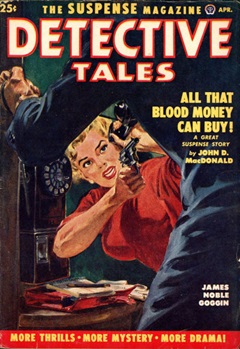
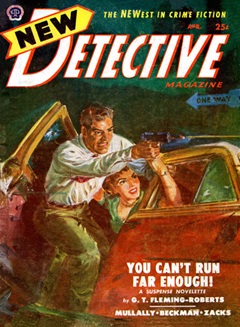
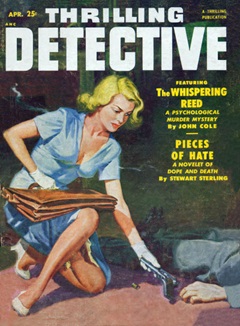
To view the entire list of weekly Old Time Radio episodes at Tangent Online, click here.
